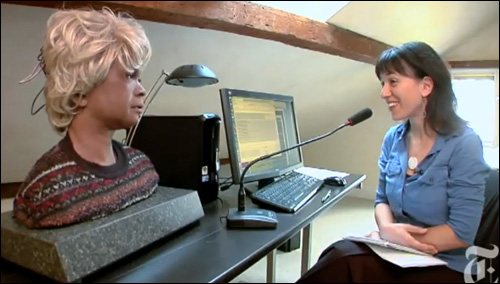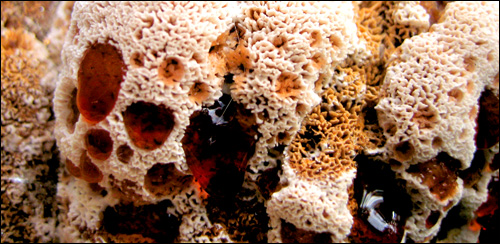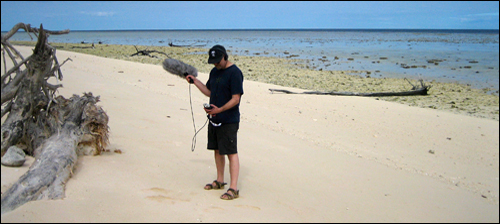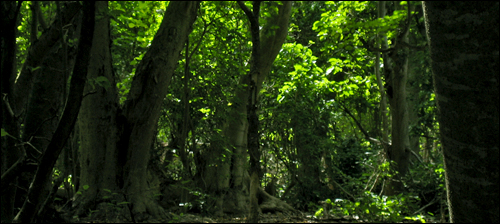Mon 2 Aug 2010
Bina There, Done That
Posted by anaglyph under Creepy, Gadgets, In The News, Robots, Science, Technology
[11] Comments

What is is with techy people when they come across robots? It seems that a machine merely has to bat a servo-driven eyelid for normally sane, balanced geeks to completely drop their brains on the floor.
Take this recent article over at the usually-sensible Engadget.
The photo you see above is of Bina48, one of the most advanced humanoid robots around. Bina48 resides at the Terasem Movement Foundation in Bristol, Vermont, and while she doesn’t exactly excel at conversation, she’s far more coherent than many we’ve spied… her existence and nearly constant evolution is pretty impressive and we’re going to keep our eye on her as we move toward the future.
In case you couldn’t figure it out, Bina is the one on the left. I know, I know, the astonishing human likeness makes it tricky to pick the robot from the New York Times reporter, but you’ll have to take my word for it. The spastic wobbling head on a plinth is in fact a machine.
Engadget’s acknowledgement that Bina ‘doesn’t exactly excel at conversation’ is somewhat of an understatement. The New York Times reporter attempted to ‘interview’ Bina and the effect is less of a conversation than something like an attempt to interpret the ravings of a simpleton on peyote.
I encourage you to watch the video of the interview now, to experience the full effect of Bina’s striking humanness.
I fail to see how this is in any way more impressive than the numerous other ‘realistic’ robots we’ve examined previously on The Cow. Engadget really needs to get out more. Perhaps on a date with Aiko or Roxxxy, who, even if not as ‘anatomically correct’ as their makers would have everyone believe, at least have bodies.
The New York Times reporter starts out bravely with Bina, but realises in two sentences that she’s been sent out on one of those stories that has little salvaging.
“Hi Bina,” she says, cheerily.
“Er… so where were we?” asks Bina, like a junkie being roused from an opium dream.
“I’m Amy. I’m a reporter,” says the NYT girl, with the sinking feeling that she’d have been better off doing the kitten-stuck-up-a-tree story.
“There is probably more to you than just that,” interrupts Bina, with a sneer. ((Seriously – we are SO attuned to facial gestures that, in my opinion, it’s way better to just forget them than to take the risk that they will be inappropriate. Watch someone closely next time you have a conversation, and see how much of the intent is carried by facial movement. You may be surprised.))
Poor Amy cuts her losses by having the story go to a voiceover:
I had lofty goals for my interview with the Bina48 robot. I imagined me, the intrepid New York Times correspondent, communing on camera with a new kind of intelligent silicon species.
Yes, dear Amy, and I bet that’s just how your editor sold it to you. Well, you’ve learned your lesson about robots haven’t you? You could have saved yourself a lot of grief if you’d been a constant reader of The Cow. We’ve covered all this in depth on numerous occasions.
Amy persists, to her detriment. She asks Bina several times if she’s ready for a conversation while the robot wobbles its badly-wigged head around, doing an uncanny impression of Parkinson’s patient trying to get out of a straight jacket. It finally decides on the well-worn AI strategy of rephrasing the question, which Amy takes as an affirmation.
“Cool!” says Amy.
“Ambiguous,” replies Bina, in an astonishingly embarrassing 1950s ‘does-not-compute’ kind of way. “Cold weather or cold sickness?”
Oh dear. That’s a big fat ‘F’ for you on the Turing Test, Bina. ((Lesson Number 2: Make sure your robot knows the difference between literalness and colloquialism. My first question to a being who I suspected of masquerading as a human would be something like ‘How’s it hangin’ dawg?’))
After an hour of ‘exhausting’ rapport with Bina, Amy calls it quits. Bina has lolled her head around, ((Maybe if they programmed her to drool? It would complement the overall effect, that’s for sure.)) interrupted the conversation with baffling observations, misinterpreted questions, and advanced her ‘opinions’ on artificial intelligence in a completely unconvincing manner, all the while effectively demonstrating that she is anything BUT intelligent. Eventually, she attempts to explain her poor performance away on ‘having a bad software day’.
“You know how that is,” she pleads. ((The programmers are obviously going for wit here, but succeed only in bathos.)) NO WE DON’T, Bina. We are humans. We don’t have ‘bad software’ days. ((That excuse is going to go down really well when the first robot babysitter to drown someone’s child in the bath tries to blame it on ‘a bad software day’.))
As I see it, every day is a bad software day for Bina. I’m perplexed when things like this get wheeled out time and time again as evidence of how the robotic future is just over the horizon. Bina is really nothing more that a mechanical appendage of software routines that have been around for decades. There are a few ‘physical’ additions (Such as Bina’s attempts to smile which are so creepy that I think makers of horror movies would do well to take notes) but all in all Bina is no more impressive than Fake Captain Kirk or Eliza. Obviously Engadget has a very different idea to me of what the future with robots ought to be like.
___________________________________________________________________________
Thanks to Atlas for providing more robot-spotting fun.
___________________________________________________________________________

















